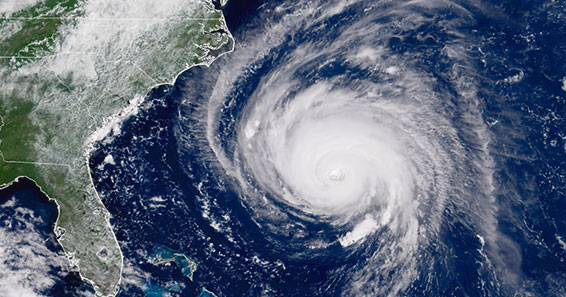Hurricane Dorian Prompts CMS Emergency Efforts
Breaking News
Literally, as we contribute to this blog space, our fellow Americans in the Southeast and Mid-Atlantic States are experiencing the dramatic effects of the monster Hurricane Dorian.
 The Centers for Medicare and Medicaid Services has just issued Medicare Learning Network (MLN) Special Editions (SEs) 19017 (Puerto Rico), 19018 (Florida), 19019 (Georgia and South Carolina) and 19020 (North Carolina) complete with accompanying press releases including information regarding suspension and enforcement activity relaxation, waivers and flexibilities, Disaster Preparedness Toolkits for affected state Medicaid agencies, access assurance to care for Medicare Advantage and Part D programs for the states that have, so far, been impacted by Dorian’s wrath.
The Centers for Medicare and Medicaid Services has just issued Medicare Learning Network (MLN) Special Editions (SEs) 19017 (Puerto Rico), 19018 (Florida), 19019 (Georgia and South Carolina) and 19020 (North Carolina) complete with accompanying press releases including information regarding suspension and enforcement activity relaxation, waivers and flexibilities, Disaster Preparedness Toolkits for affected state Medicaid agencies, access assurance to care for Medicare Advantage and Part D programs for the states that have, so far, been impacted by Dorian’s wrath.
Repeatedly
We can almost schedule a blog on this subject once per year, these days. The United States has repeatedly been thrown into disaster relief and mitigation as storms of this caliber grow in intensity.
Natural disasters the caliber of Dorian force emergency services into immediate action. News and social media feeds featured streams of ambulance strike-force convoys rolling into the affected areas from the northern and western states. The emergent nature of these events necessitates a quick response from EMS. Although these transports are extremely critical to protect patients from harm in the moment, these transports often do not fit “normal” medical necessity criteria or even origin and destination requirements.
After the storm
Once the storm has passed and the danger no longer lingers, it’s then that those of us in the ambulance billing office realize that seeking reimbursement to cover the cost of providing the emergency transportation services is elusive. Considering that Dorian is a slow-mover and impacted these regions for now well over a week both, directly and indirectly, one can begin to add up the cost of fuel, wages and overtime, logistical support costs not to mention the lost revenue resulting from daily transport volume and billing interruptions. It all can be quite staggering, monetarily, for agencies involved in the evacuation and disaster relief efforts.
Who pays the bills?
Consider right up front that the traditional insurance payer sources may not be the same players delivering the reimbursement stream to cover these unexpected costs.
Medicare and Medicaid have allowed exceptions in the past using programmatic waivers based on Section 1135 of the Social Security Act. Under Sections 1135 and 1812(f) of the SSA, CMS has the ability to issue several “blanket waivers” for the impacted geographical areas where disasters strike.
The intent of these waivers is to prevent gaps in access to care for patients impacted in emergencies such as Dorian. If a blanket waiver is issued, then the waiver spells out the healthcare access gap that will be covered by the exception. If no blanket is issued, ambulance providers and suppliers may still apply for an individual waiver specific to their situation.
1135 Waiver Policies and Procedures
Today’s MLN SE communications point healthcare providers, including ambulance services to the CMS March 15, 2019, Medicare Fee-For-Service Emergency-Related Policies and Procedures document regarding §1135 waivers, specifically Section F of the document which covers Ambulance Services.
The section outlines how an ambulance service “may” be paid for evacuation transports in times of disaster but certainly does not guarantee payments. This section also outlines the use of the DR (disaster-related) condition code and CR (catastrophic/disaster-related) modifier to be used when submitting resulting claims for payment of these spur-of-the-moment inter-facility transfer transports.
In all, the document includes ten separate Q&A guidance instructions covering the scenarios and “how-to” for eventual billing, after the fact.
We recommend…
Since the rules for billing these incidents are vague and situational, we recommend that EMS agencies take the following steps…
- Be certain that you and your staff have documented the unique circumstances for each and every disaster transport in the greatest detail possible in the patient care report (PCR).
- Record who requested the ambulance transport. Capture the person’s title and role along with the nature of the original request for ambulance transportation.
- Be sure to collect any and all insurance payer information, next-of-kin information and archive the names and contact information for any and all persons that affiliate with each patient. It is important to record, in writing, the origin and destination location for the patient and maintain and archive all supporting written document that you were provided prior to or during the transport. Of course, attempting to obtain and secure an appropriately-signed Physicians Certification Statement (PCS), whenever possible, is also highly recommended.
- Finally, don’t be afraid to file for and request special exceptions whenever and wherever possible and at all levels- both governmental and commercial payer-source based. If all else fails and you find that your agency is now on the hook for un-reimbursed costs that are disaster-related, consider filing a request for reimbursement with the Federal Emergency Management Agency (FEMA) and/or applicable state emergency management agencies.